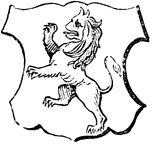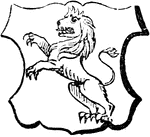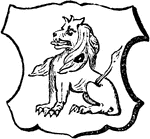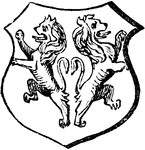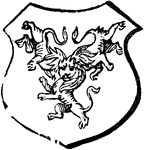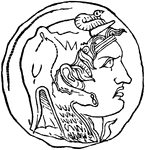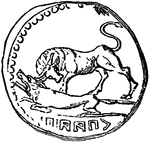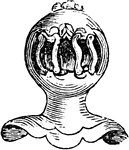
Grated Helmet Direct
"The position of the helmet is a mark of distinction. The direct front view of the grated helmet belongs…

Girl Facing Away & Holding Hands Behind Back
An illustration of a girl facing away and holding hands behind her back.
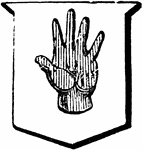
Knight and Baronet of King James I
"KNIGHT AND BARONET. A degree of honour next to a baron, created by King James I. to induce the English…
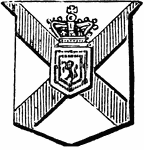
Knight and Baronet of Nova Scotia
"KNIGHT AND BARONET OF NOVA SCOTIA. A new creation during the reign of George I. to induce capitalists…
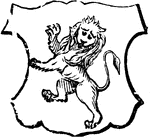
Lion Rampant Gardant
"Lion rampant gardant. RAMPANT. Any beast in a fighting attitude." GARDANT. Facing foward. -Hall, 1862

Lion Rampant Regardant
"Lion rampant regardant. RAMPANT. Any beast in a fighting attitude. REGARDANT. An animal looking towards…

Lion Statant Gardant
"Lion statant gardant. STATANT. An animal standing still with all its legs on the ground." GARDANT.…
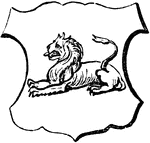
Lion Couchant
"Lion couchant. COUCHANT. The French word for lying down with the breast towards the earth, and the…

Lion Dormant
"Lion dormant. DORMANT. The French word for sleeping, used to denote the posture of a lion, or any other…
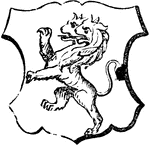
Lion Rampant Double-Headed
"Lion rampant double-headed. RAMPANT. Any beast in a fighting attitude." -Hall, 1862

The Stoning of Zechariah
"And they conspired against him, and stoned him with stones at the commandment of the king in the court…

Hezekiah Cleansing the Temple
"And they gathered their brethren, and sanctified themselves, and came, according to the commandment…
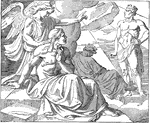
Daniel Refusing to Worship the Image
"But if not, be it known unto thee, O king, that we will not serve thy gods, nor worship the golden…

Daniel Interpreting the King's Dream
"But there is a God in heaven that revealeth secrets, and maketh known to the king Nebuchadnezzar what…

The Return of the Jews from Captivity
"Now these are the children of the province that went up out of the captivity, of those which had been…
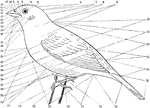
Topography of a Bird
"fig. 25 - Topography of a Bird. 1, forehead (frons). 2, lore. 3, circumocular region. 4, crown (vertex).…

Bust of Plato
Plato was a Classical Greek philosopher, mathematician, writer of philosophical dialogues, and founder…
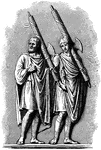
Roman Civil Servants
An illustration of two lictors, members of a special class of Roman civil servants. Lictors had special…
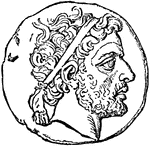
Philip V of Macedonia Coin
An illustration of a coin with the face of Philip V of Macedonia. Philip V was King of Macedonia from…
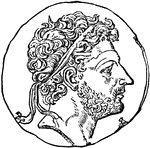
Perseus of Macedonia Coin
An illustration of a coin with the face of Perseus of Macedonia. Perseus the legendary founder of Mycenae…
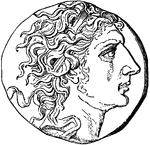
Mithradates VI Coin
An illustration of Mithradates VI on the face of a coin. Mithradates VI was king of Pontus in northern…

Bust of Mark Antony
Marcus Antonius, known in English as Mark Antony, was a Roman politician and General. He was an important…

Coin of Vespasian
Titus Flavius Vespasianus, commonly known as Vespasian (November 17, 9 – June 23, 79), was a Roman…
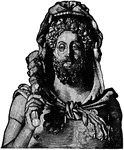
Bust of Commodus
Lucius Aurelius Commodus Antoninus (31 August 161 – 31 December 192) was a Roman Emperor who ruled…

Profile of Charlemagne
An illustration of the profile of Charlemagne, also known as Charles the Great, was King of the Franks…
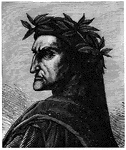
Portrait of Dante
An illustration of a man being knighted on a battle field. Durante degli Alighieri (May/June c.1265…
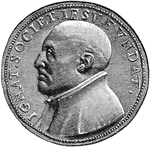
Saint Ignatius of Loyola Coin
An illustration of a coin depicting Saint Ignatius of Loyola. Saint Ignatius of Loyola (Spanish: Ignacio…
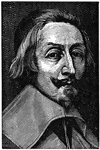
Cardinal Richelieu
Armand Jean du Plessis de Richelieu, Cardinal-Duc de Richelieu (9 September 1585 – 4 December…

Oliver Cromwell
Oliver Cromwell (born April 25, 1599 Old Style, died September 3, 1658 Old Style) was an English military…
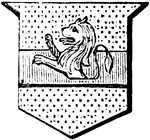
Lion Naissant
"Or, from the midst of a fess, gules, a lion rampant naissant. NAISSANT. A French word signifying coming…

Girl Scolding Young Child
An illustration of a young girl holding an apple behind her back while scolding a young child.
Sceptre with the Dove
"The sceptre with the dove is of gold, three feet seven inches long; the circumference of the handle…
Sceptre with the Cross
"The royal Sceptre with the Cross is of gold; the handle is plain, and the upper part wreathed; it is…

Man Carrying Woman on Back Near Town
An illustration of a man carrying a woman on his back with a town in the background.

Obverse Side of George-Noble
"Obverse. George-noble of Henry VIII. GEORGE-NOBLE. An English gold coin of the reign of Henry VIII.,…
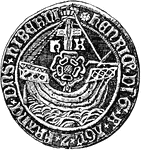
Reverse Side of George-Noble
"Reverse. George-noble of Henry VIII. GEORGE-NOBLE. An English gold coin of the reign of Henry VIII.,…
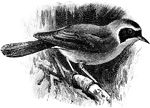
Common Yellowthroat
The Common Yellowthroat or Maryland Yellowthroat (Geothlypis trichas) is a bird in the Parulidae family…
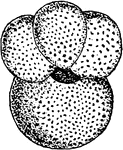
Globigerina
"Globigerina bulloides. GLOBIGERINIDAE. A family of chiefly pelagic foraminiferous rhizopods, with the…
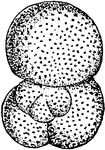
Globigerina
"Globigerina bulloides. GLOBIGERINIDAE. A family of chiefly pelagic foraminiferous rhizopods, with the…
Clingfish
Gobiesox reticulatus is a species of Clingfish, a bottom dwelling fish that live in shallow waters.

The Bones of the Right Wing of a Duck
"Fig 27. - Bones of the right wing of a duck, Clangula islandica, A, shoulder, omos; B, elbow, ancon;…
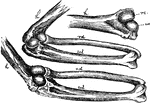
Mechanism of the Elbow-Joint
"Fig. 28. - Mechanism of elbow-joint. ..., where rc and uc show respectively the size, shape, and position…

Robin
"Robin: Upper parts slate-color, with a shade of olive. Head black, the eyelids and a spot before the…
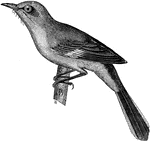
Mockingbird
"Mocking-Birds. Bill much shorter than head, scarcely curved as a whole, but with gently-curved commissure,…

Christ on the Mount of Olives
Christ on the Mount of Olives is an engraving by Albrecht Dürer in 1508. It is part of a series…
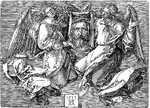
Two Angels with St. Veronica's Napkin
Two Angels with St. Veronica's Napkin is an engraving that was created by German artist Albrecht Dürer…

St. Jerome In His Cell
St. Jerome in his Cell is an engraving that was created by German artist Albrecht Dürer in 1514.…
Margin Drawing
This margin drawing was created by German artist Albrecht Dürer in 1515. It is found in the prayer…
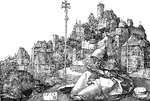
St. Anthony
This is an engraving of St. Anthony by German artist Albrecht Dürer in 1519. It shows a view of a view…
